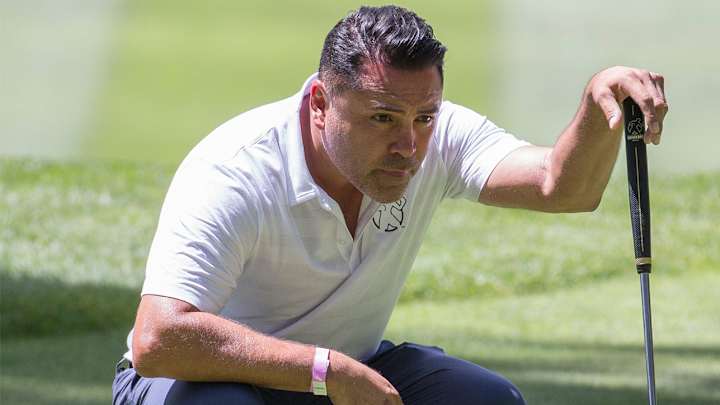Despite All the Risks, Oscar De La Hoya Can Never Truly Quit Boxing

When Oscar De La Hoya confirmed to ESPN last week that he planned to return to boxing, almost 12 years after his last fight, at the age of 47, the news reminded me of one relevant stretch in 2013. De La Hoya had transitioned from the end of his fighting career to running his own promotional company, and his prized signee, Canelo Alvarez, was set to fight reigning pound-for-pound king Floyd Mayweather Jr. in Las Vegas.
I was writing for the New York Times then, and I spent maybe eight days with De La Hoya in Los Angeles and Manhattan. I watched him tape television appearances, film promotional spots and in-depth interviews, play charity golf and conduct business meetings. We even played a round at Donald Trump’s golf course in California, the one nestled against the Pacific Ocean. The boxer made birdies. The journalist took notes and shanked a few drives. Afterward, we went to the clubhouse to grab a bite and conduct an interview.
I wanted to ask the boxer known as The Golden Boy about his life then, especially, at 40, as the man who had literally been knocked out of boxing by Manny Pacquiao; who had gone to rehab for alcohol and cocaine abuse and all the pictures of parties and fishnets; gotten clean; reconnected with his children; reclaimed much of what he had lost. But what stood out wasn’t any sort of redemptive narrative, but rather a man who knew what he wanted to project—stability, happiness, the success of his second act—and couldn’t let go of the sport where he now stood on the side, rather than in the ring. I went back and checked my notes this week. He said he wanted to return to boxing, unprompted, five times during that half-hour exchange. He told a joke about asking his wife if he could return and her responding “do what makes you happy” in the kind of flat tone that indicated she didn’t favor any sort of comeback.
There didn’t seem any reason to take him too seriously on that front. The retired boxer said he had funneled his ring-intensity into golf, playing 43 straight days that spring before he forced himself to take a day off. This routine, he said, helped him fight off boredom; the longing for the height of his career, when he ranked among the planet’s most famous athletes; and his urges for booze and drugs. It all sounded good, if not too perfect.
This was De La Hoya after all, boxing’s most famous chameleon, a man who seemed to present to others whatever he thought they wanted him to be. That lesson would be underscored the week of the fight, when, after writing a 4,000-word missive on The Golden Boy turned Golden Boy Promotions, I received a tip that we shouldn’t run the piece from someone in his camp. Not under any circumstances, the person said. The next day, the news broke. De La Hoya, on the eve of his apex as a promoter, had gone back to rehab.
Any comeback hopes seemed completely dashed at that point. But De La Hoya, the former gold medalist from the 1992 Olympics, the 11-time champion in six weight divisions, the Pay-Per-View star who hung out with celebrities, the rare boxer who was legitimately famous, he never could let go. Very few fighters can, which always seemed odd, starting with the very nature of their profession. Like, who wants to stop getting hit in the face, retire to a life of golf and mansion-living in your 40s, then decide to willingly get hit in the face again? Most boxers, apparently. That’s a story as old as the sport itself.
I wish boxing as a sport would stop this nonsense, stop trading on bankable names when there’s nothing left except the letters emblazoned on the waist of their trunks. I don’t want to watch Roy Jones Jr. get knocked out in Moscow on a network no one has ever heard of. I didn’t want to watch Shane Mosley’s obvious decline.
It’s understandable that De La Hoya would want to return, that there remain various pulls, for fame and celebrity and relevance. I’d buy that boxing is in his blood, too, and that promoting fights, even selling a star like the one that Alvarez has become, cannot compare to stepping inside the ring himself. Of course, the almost AARP-eligible once-Golden Boy is free to make his own decisions, no matter how ill conceived. None of that makes this return a good idea. Not for that kind of long-term health risk.
Back in 2013, I ended the piece I wrote after De La Hoya went to rehab with the metaphor he seemed most fond of, the comparison he made to explain his story. The metaphor always felt a little too neat, too tidy, and yet, it seems particularly revealing now. The hardest thing in boxing, De La Hoya said, over and over, was when a fighter is knocked down and must rise from the canvas, knowing he will inevitably lose. In 2020, it’s apparently harder not to fight, even with an inevitable loss lingering, closer now than ever.

Greg Bishop is a senior writer for Sports Illustrated who has covered every kind of sport and every major event across six continents for more than two decades. He previously worked for The Seattle Times and The New York Times. He is the co-author of two books: Jim Gray's memoir, "Talking to GOATs"; and Laurent Duvernay Tardif's "Red Zone". Bishop has written for Showtime Sports, Prime Video and DAZN, and has been nominated for eight sports Emmys, winning two, both for production. He has completed more than a dozen documentary film projects, with a wide range of duties. Bishop, who graduated from the Newhouse School at Syracuse University, is based in Seattle.
Follow GregBishopSI